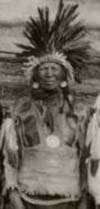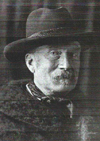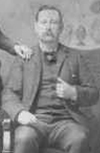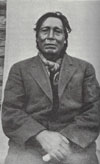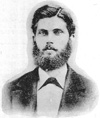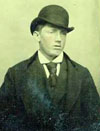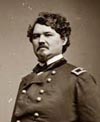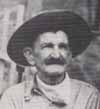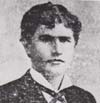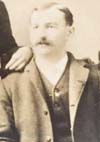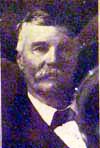May 7, 1868 – The Treaty of Fort Laramie with the Crow was concluded.
John Fitzgerald died in New York City on May 7, 1900, and was buried in Calvary Cemetery in Woodside, Queens County, New York. He was the Farrier for Company C who participated in the hilltop fight.
Soldier (left), an Arikara Scout, died on May 7, 1921, and was buried in the Indian Scout Cemetery in McLean County, North Dakota. His gravestone states, “Served his country as an Indian Scout.” He was with Reno’s Column, but he did not cross the river.
Good Elk (Wah-nee), an Arikara Scout who was also known as Red Bear, died in Nishu, North Dakota, on May 7, 1934, and was buried in the Indian Scout Cemetery in McLean County, North Dakota, where he is listed as Handsome Elk. He participated in the valley fight.
Charles Sanders was born on May 8, 1842, in Altenberg, Germany. He was a Private in Company D who served as the Orderly for Lt. Winfield Scott Edgerly and participated in the hilltop fight during the battle.
Edward Garlick (left) was born in Chertsey, England, on May 8, 1846. He was the First Sergeant for Company G who was on furlough at the time of the battle.
Jeremiah Campbell died on May 8, 1884, in Decatur, Illinois, and was buried in Westside Cemetery in Moweaqua, Shelby County, Illinois. He was a Sergeant in Company K who participated in the hilltop fight.
Thomas Wellesley Causby (left) was born on May 9, 1848, in Liverpool, England. He was the Staff Quartermaster Sergeant, but he was not present at the battle due to detached service at Powder River, Montana.
May 9, 1887 – Buffalo Bill’s Wild West Show opened in London.
Jasper Rudolph Marshall died in Pleasant Hill, Ohio, on May 9, 1920, and was buried in the Pleasant Hill Cemetery. He was a Private with Company L who was with the pack train and participated in the hilltop fight.
May 10, 1868 – The Treaty of Fort Laramie with the Cheyenne and Arapahoe was concluded.
William Earl Smith died on May 10, 1918, in South Deerfield, Franklin County, Massachusetts, and was buried in the Brookside Cemetery there. He was a Corporal with Company B who was with the pack train and was wounded during the hilltop fight.
Charles Henry Bishop was born in Washington, D.C., on May 11, 1854. He was a Private with Company H who was wounded during the hilltop fight.
Francis Johnson Kennedy (left), who was also known as Francis Johnson, was born on May 12, 1854, in Pacific, Missouri. He was a Private in Company I who was with the pack train and participated in the hilltop fight.
Strikes the Bear (right), an Arikara Scout who was also known as Red Star, died on May 12, 1929, in Ree, North Dakota, and was buried in the Indian Scout Cemetery in McLean County, North Dakota. His gravestone states he died on May 12, but other sources state he died on June 7, 1929.
Jacob Adams (left) died in Vincennes, Knox County, Indiana, on May 13, 1934, and was buried in Mount Calvary Catholic Cemetery there. He was a Private with Company H who was with the pack train and participated in the hilltop fight.
